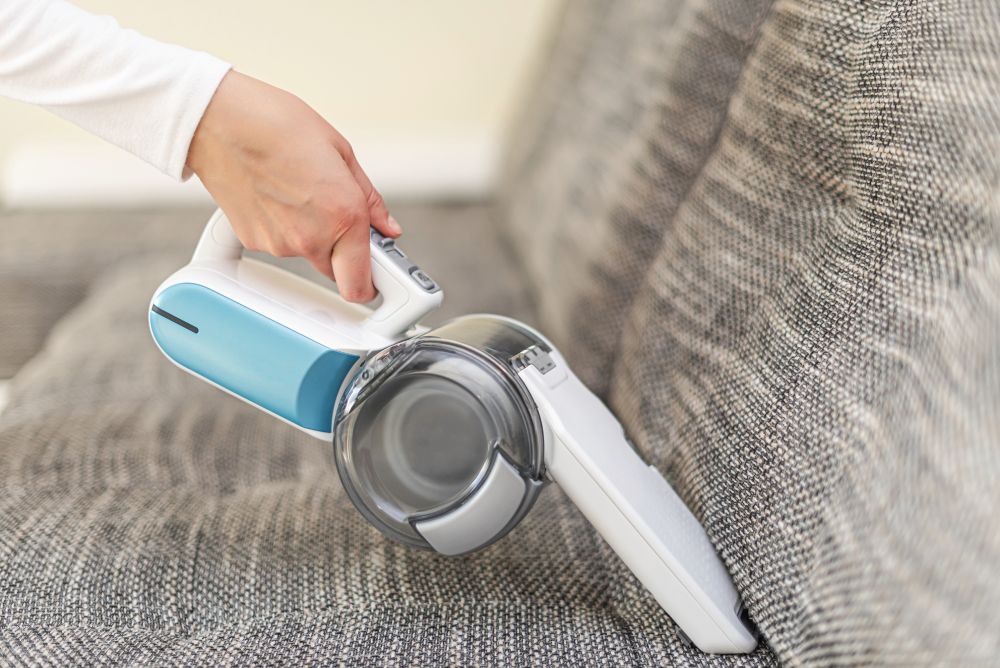In this article
When dealing with cockroaches, pets can make a tricky situation even more challenging. Roach infestations are persistent and aggravating, putting households at risk of diseases and triggering allergies and asthma.1 Deterrents create a barrier against bugs, but when those fail, you’ll need to pull out the roach killers in an integrated strategy to beat the problem. And that often includes harsh pesticide treatments to root them out.
Unfortunately, the most potent products are usually the most hazardous to pets. Rather than risk putting them in a dangerous situation, we must find clever alternatives. We’ll show you the perfect compromises with these powerful and pet-friendly solutions to kill and repel roaches without harming your dog.

The 3 Pet-Friendly Roach Killers
Many commercial and DIY roach killers are poor choices because of concerns over safety and effectiveness. Aerosols and total-release foggers (“bug bombs”) are popular products, but they can be toxic to people and pets when sprayed and leave pesticide residues afterward. They’re also not particularly effective.2
When used properly, baits typically work better than sprays and don’t subject people or pets to toxins after use. Most compounds used in baits are now also relatively dog-safe. Active ingredients like fipronil or dinotefuran are common in dog parasite prevention treatments, and the dosage of any chemical in most cockroach baits is too minute to cause anything other than mild GI upset.
However, some baits are problematic because of their packaging. If a dog eats the plastic housing of a roach bait, they may develop severe intestinal issues. For the most all-around safety for your dog, you can try these three dog-friendly roach killers.
1. Cockroach Gel Baits

Cockroach gel baits are easy-to-use roach killers and a safer alternative to bait stations. Like the stations, they will attract dogs. However, a lack of plastic housing makes them less likely to cause health issues.
Baits come in a syringe, allowing you to place small dots or lines of gel wherever cockroaches might pass by and pick it up.
The active ingredient in the baits is indoxacarb, which is an insecticide that disrupts the nervous system, leading to death. Cockroaches find it highly palatable and ingest and metabolize it. Indoxacarb lasts several generations, so it can spread through a colony and destroy several bugs after only one cockroach eats it. Meanwhile, a dog would need to ingest excessive amounts (e.g., eating a whole tube) for significant issues to occur.
How to Use Cockroach Gel Baits
Although a taste or two of gel bait won’t harm a dog, you’ll still have to keep it away from your pet to ensure they don’t eat it before the roaches do.
Apply gel baits to dry, hidden areas your dog can’t reach but cockroaches frequent, including:
- Under refrigerators and microwaves
- In kitchen cabinets
- Under sinks
- Against kitchen counter backsplashes
Applications are usually pea-sized drops. The amount to apply will vary according to the type of cockroach and the particular product. Always follow the package’s directions. After about 3–7 days, you should see fewer adults scuttling around.
2. Food-Grade Diatomaceous Earth

Diatomaceous earth (DE) is a silica powder derived from fossilized remains of tiny aquatic organisms called diatoms. As a pest control measure, DE is a desiccant. It absorbs oils and moisture from insects, causing them to dry out and die. Thanks to its coarse texture, DE can also cut into insects passing over it, allowing it to get into wounds and speed up the process.
Food-grade diatomaceous earth isn’t hazardous to dogs in small amounts. While generally safe, breathing the powder can cause face, throat, or lung irritation, so you’ll still want to limit access for your pet.
How to Use Diatomaceous Earth for Cockroaches
As with gel baits, you’ll want to apply DE to dry areas where cockroaches often travel. Spread a light application with a sifter or duster. Cockroaches will be less likely to venture over large piles of it.
Use diatomaceous earth around baseboards, kitchen counters, cabinets, under sinks, and entry points like windows and doors. Results should be visible within 1–3 weeks so you can see whether you need repeat applications.
3. Insect Growth Regulators

Insect growth regulators are a critical component of an integrated strategy to control cockroaches. They work by disrupting a cockroach’s development and molting cycle, causing sterility and death. Since they target the cockroach’s unique biology, they generally have low toxicity for people and other animals.
Many IGRs come as sprays, which are generally safe for dogs once they dry, though that can take up to two hours. Others, like Gentrol Point Source, are small products you can place in out-of-the-way areas that cockroaches access and dogs can’t, giving you a safe, ongoing control solution.

Are Cockroach Glue Traps Safe Around Dogs?
Glue traps work alongside IGRs and gel baits to control cockroaches. An insect attractant draws roaches onto an inescapable glue pad, where they eventually expire. After 3–5 days, you should notice the trap filling with insects.
The makeup of glue trap boxes is typically non-toxic, but the glue is extremely sticky. If you use them in a house with pets, you cannot allow them to get their paws or muzzles into the traps. Removing them from your dog can be painful, often causing skin irritation and hair loss.
Since it’s one of the few control measures that shows results, the glue trap makes an excellent monitoring tool to gauge the effectiveness of your entire cockroach removal strategy. You can move traps around if you aren’t getting results, but generally, if you don’t see them collecting any bugs for 2–4 straight weeks, your extermination attempts were likely successful.

Is Boric Acid Safe to Use Around Dogs?
Boric acid is another powder that can kill cockroaches. The particles cling to roaches as they pass over them. Upon grooming themselves, they’ll ingest the acid, which then works to damage the bugs’ nervous systems.
While boric acid is relatively safe for use around pets in low amounts, it can be moderately toxic when inhaled or ingested in large amounts. Signs like vomiting, fever, or depression appear within two hours. In large quantities, boric acid can cause more severe issues, including seizures, ataxia, and kidney and liver problems.
Boric acid can be safe if used correctly, but safer alternatives exist.

The 3 Pet-Friendly Roach Repellents
Once you get the cockroaches out of the house, you must take steps to avoid another infestation. Prevention is far different than eradication. Rather than attracting cockroaches to kill them, you’re now trying to repel them away from your property.
1. Catnip

Natural cockroach repellents are eco-friendly and easy to use but not always practical in a house with dogs. Their limited effectiveness is one issue. If you use natural deterrents, you must typically use them alongside other prevention strategies. Many essential oils and spices can also irritate dogs if they ingest them, with some, like onion and other Allium plants, being immediately toxic.
Catnip is one exception. The feline favorite is safe for dogs to consume as well. For cockroaches, the nepetalactone compounds in catnip are highly off-putting. While the essential oil extract is most effective, you can place small packs of catnip around cockroach hotspots to keep them out of pantries, kitchen cabinets, and other off-limits areas.
2. Rosemary Oil

Essential oils are common all-natural pest repellents, but the toxicity of many popular varieties, like tea tree oil, can irritate your dog if it gets on their skin or in their mouth. However, rosemary can be a safe and highly effective option.
The flavorful culinary herb even appears in some dog diets, offering antioxidant and digestive help. Though more potent and potentially harmful in a concentrated oil, diluting it with water in a spray will be less likely to cause adverse effects.
Mix a few drops of rosemary oil with a cup of water. Spray it around areas with high cockroach activity, including around doors, in cabinets, and behind appliances. While it’s an excellent repellent, rosemary oil is also one of the more toxic oils for some cockroach species, helping you deter and kill existing pests with surprising efficiency.3
3. A Clean Home

A cleaner space is something everyone in the home can enjoy, except for cockroaches, that is. You can keep roaches, mice, and other critters disinterested in your house if they can’t find food, shelter, or water.
- Sealing your garbage bin
- Putting dog food away at night
- Sweeping and vacuuming floors
- Wiping down countertops
- Storing food in airtight containers
- Washing dirty dishes and cleaning the sink
- Removing clutter
Cleaning up any water sources works the same way. Essential home maintenance, such as repairing leaky pipes, insulating sweating HVAC lines, and cleaning gutters and downspouts, will eliminate many spots where cockroaches like to stay.

When to Call an Exterminator
Cockroaches mature and multiply quickly, producing hundreds of offspring and several generations in only a few months. Without thorough eradication in all areas where they might hide, it can take only a couple of survivors a short time to regrow the population. Although DIY products can be helpful, many consumers lack the resources and know-how to eliminate the problem.
Considering their dependability, calling a professional exterminator after the first sign of cockroaches is never a bad idea. If you’ve gone through several rounds of DIY attempts and still see the same amount of bodies in your glue traps, it’s a necessity.
Remember that the sprays, powder, and heavy-duty treatments professionals use aren’t always dog-friendly. Tell your exterminator about the pets in your home so they can create a strategy that caters to them. As with spray IGRs, many professional solutions only require pets to stay out of the house for a few hours to let the solutions dry.


Final Thoughts
Pest treatments have become more pet-friendly and efficient over the last few decades, giving us better solutions with fewer hazards. But that doesn’t mean you can skip the research. Even products labeled as “pet-safe” can be harmful if used incorrectly. To keep your dog safe and your home pest-free, stick with these pet-friendly roach killers and repellents and don’t hesitate to contact the pros when the problem becomes too much to handle.
Related Reads:
- Can Dogs Eat Bugs? What the Science Says
- Diatomaceous Earth for Dogs: Vet-Approved Types, Pros, Cons & FAQ
- 4 Pet Safe Insecticides to Use at Home: Safety & Facts
Featured Image Credit: Anna Hoychuck, Shutterstock



















